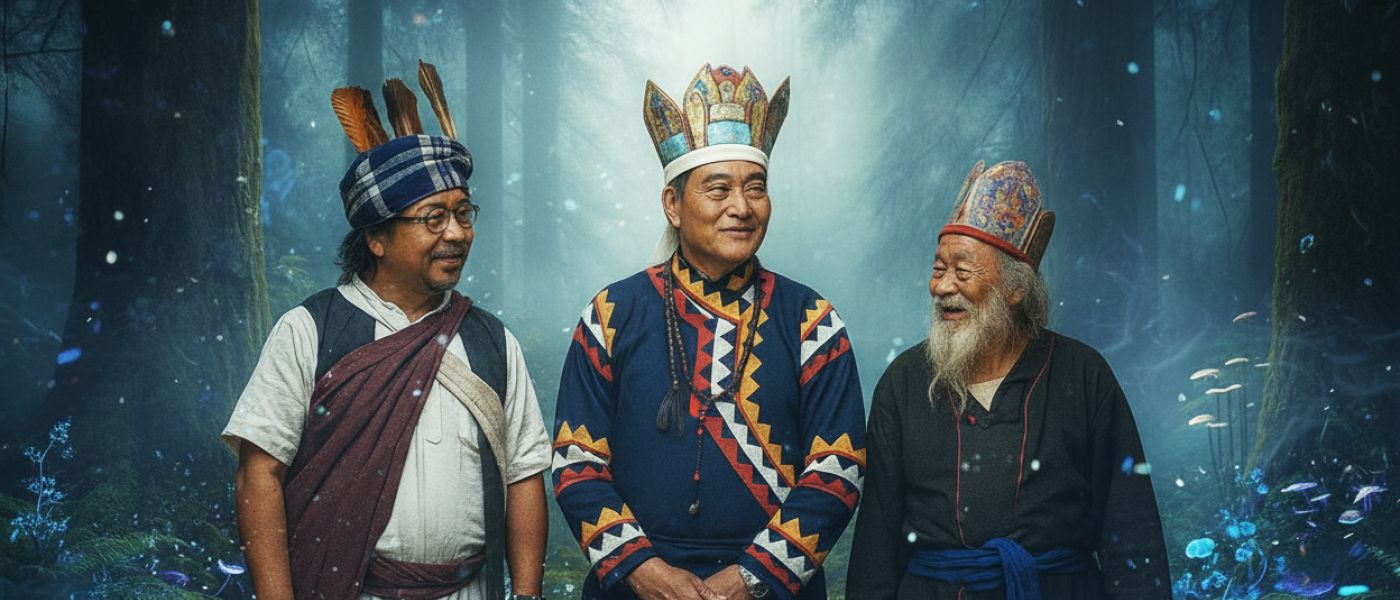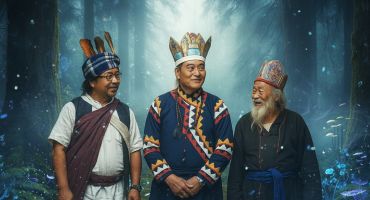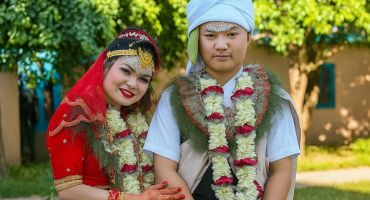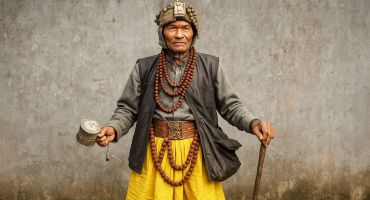When one turns to the shamanic world of the Gurung people, the first aspect likely to emerge is a taxonomy of ritual specialists distinct in function yet deeply integrated into the social space of the community. Within this triadic structure are the Pachyu, Khlepree (or Gyabri), and Bonpo Lama. These shamans hold significant spiritual authority that permeates the social, moral, spiritual, and cosmological order of the Tamu Gurung world.
Although the Gurungs mostly follow Buddhism today, they have preserved an unbroken tradition that anchors them to their most primordial customs that carries the memory of an older cosmology. This spiritual worldview predates the monasteries and mantras of the later faith. The precise timeline when the Gurungs of central Nepal turned toward Buddhism is unclear, yet what remains undeniable is their loyalty to that ancestral vision. They continue to preserve a vivid, layered shamanic world where nature and humanity, the living and the departed, move together to help retain ancestral memory and ethnic identity.
In part, these enduring traditions find their expression in the rituals of the Gurung shamans themselves, whose practices are meant to ensure a connection between the visible world of the living and the vast unseen realm of spirits and ancestors.
But beyond ritual and custom, the Gurung shamanic complex embodies a broader anthropological principle. The reciprocal entanglement of cosmology, and social organization are all ritual sequences that open up as a site of healing and instruction. It transforms into a performative space where gesture and chant become a medium of discourse between human and spirit, and ancestor and descendant. For both the ethnographer and the attentive witness, Gurung shamanism, thus becomes a living epistemology that consistently demonstrates that ancestral wisdom is perpetually renewed and rendered relevant across generations.
At the heart of Gurung world of rituals is the Pachyu, the animistic Shaman. He mediates across the porous boundary between the physical and the spiritual, and is generally revered as healer, diviner, and custodian of balance. The Pachyu’s vocation is typically lineage-bound, passed through generational ritual authority, where a child grows under the steady beat of Shamanic chants and drumbeats. Through trance and invocation, the Pachyu is expected to confront afflictions attributed to the intrusion of Ra Lung (restless spirits), Sa Lung, (the wandering of the soul), or the wrath of La Tung (local deities), restoring equilibrium to the afflicted and to the moral order of the community itself.
While performing healing rituals, the Pachyu employs various rites. From soul retrieval to spirit negotiation, or invoking compassion-driven helper spirits of the phu-rhin (higher world) and sam-rhin (lower realms), their functions are both curative and spiritual.

Beyond grave rites, they also act as social mediators in domestic disputes, interpreters of omens, and guides during life-cycle rituals such as marriages and house blessings. Within Gurung society, the office of the Pachyu is largely hereditary, confined to a few clans or thars known for their animistic practice. This continuity reflects the enduring strength of a clan-based system through which sacred knowledge and ritual authority have been carefully preserved across generations.
Khlepree or Ghyabri are shamans who are particularly associated with the Pae or Arghum, the multi-day funerary ritual performed to escort the departed soul safely to the Land of the Ancestors (Mithen). Central to the entire ritual is the phase known as Rhiteba, a performative rite where an effigy of the deceased, often a bamboo frame dressed in the deceased’s clothing, becomes a conduit for the spirit. The Khlepree, accompanied by rhythmic drumming and the clash of large brass cymbals, leads a sacred dance around the effigy, commanding the soul to release its attachment to the world of the living.

The Khlepree recites long epic narratives that chart the soul’s journey to the ancestral realm. His chants, called Phepung, are dense with mythic imagery and genealogical memory, as he evokes the origins of the world, the descent of ancestors, and the creation of ritual order. To speak them rightly is to renew the community’s link to its divine beginnings, thus making the Khlepree a true keeper of the Tamu oral tradition.
The Bonpo Lama, while less visible in everyday healing, represents the syncretic heritage of Gurung ritual life. Descended from pre-Buddhist Bonpo traditions yet often integrated into contemporary Buddhist system these priests recite the Pe or Pye-Tan Lu-Tan. These are orally transmitted sacred texts that encode cosmological narratives and mythic genealogies. The ritual language is deliberately archaic, occasionally opaque to lay Gurung speakers, which usually gives the Bonpo the sacred authority of the officiant while preserving an intangible heritage that bridges past and present.

In Gurung culture, shamans acquire their sacred knowledge through either lineage, tutelage or under an experienced practitioner, or through spontaneous spiritual revelation in youth. While the capacity to perceive and interact with spirits is considered an innate or divinely awakened gift, often signaled by ancestral calling or life-changing experiences, the practical dimension of shamanic knowledge can only be cultivated through meticulous apprenticeship.
Young initiates, born into shamanic families begin by observing and participating in rituals alongside elders, memorizing sacred chants, learning the sequence of ceremonies, and mastering the use of ritual instruments. Over time, as they internalize the spiritual and symbolic context of the rituals, their latent shamanic capacity is refined, allowing them to channel divine forces, negotiate with spirits, and perform soul-guidance and healing practices.
For those without a shamanic lineage, entry into the Gurung tradition begins with the selection of a teacher, often on a full moon day, and the establishment of a formal apprenticeship marked by a humble offering. The student may live with the teacher, assisting with daily tasks while dedicating evenings to learning chants and ritual practice. Over five or six years, the apprentice accompanies the teacher during different ceremonies, internalizing the ritual and technical dimensions of the vocation. When deemed ready to “carry the load,” the student masters the three-day Pae ceremony. This rite in culminates in the physically and spiritually demanding task of dragging a sacrificial goat in a precise sequence while surrounded by other shamans and veiled mourners. Successful completion affirms mastery of ritual knowledge, skill, and composure, marking the apprentice’s initiation as a fully recognized Shaman capable of serving the community.
Observation of Gurung shamanic ritual reveals a meticulously orchestrated interplay of sound and movement. Drums and cymbals remain the most important tools while other ritual paraphernalia, like umbrellas and ceremonial shields, demarcate sacred space and manifest the cosmological order where spirits and humans meet. Offerings of goats, roosters, rice, and local liquor function as deliberate gestures of mediation, appeasing spirits, honoring ancestors, and restoring social and spiritual equilibrium. Each element carries multiple layers of symbolism during the rite.

Perception of shamans within Gurung society is nuanced. They have the utmost respect as custodians of sacred knowledge and mediators of misfortune. However, their practices coexist on the sidelines of the Buddhist and Hindu belief systems. Nonetheless, a majority of the Gurungs may attend Buddhist ceremonies and Hindu festivals but the shamanic rites persist as essential, particularly in matters concerning death, illness, and the unseen forces that structure daily life.
The sociocultural role of Gurung shamans extends well beyond the effectiveness of their rituals. By mediating relationships between humans, spirits, and the natural environment, they help uphold communal norms as well as the transmission of knowledge across generations. Their presence reflects both continuity and resilience, demonstrating a Tamu worldview in which the material and spiritual realms are closely connected. In the context of globalization, the persistence of Gurung shamanism ultimately highlights the strength of indigenous knowledge systems and the continuing importance of ritual in maintaining social cohesion and community well-being.





Leave a Reply